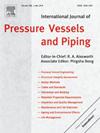Study on creep deformation behaviour of various zones of 304HCu SS weld joint using impression creep tests
IF 3
2区 工程技术
Q2 ENGINEERING, MECHANICAL
International Journal of Pressure Vessels and Piping
Pub Date : 2025-02-28
DOI:10.1016/j.ijpvp.2025.105493
引用次数: 0
Abstract
The present study investigated the creep behavior of different microstructural zones—base metal (BM), weld metal (WM), and heat-affected zone (HAZ)—in a multi-pass GTAW welded 304HCu stainless steel (SS) tube joint, fabricated using ER304HCu filler wire having higher wt% of Ni and Mn. Impression creep tests were conducted at 873–973 K under stresses ranging from 525 to 730 MPa. The BM and WM exhibited a true stress exponent of ∼5, indicating dislocation climb as the dominant creep mechanism, whereas HAZ showed a stress exponent of ∼3, suggesting dislocation glide as operating creep mechanism. Among the three zones, WM demonstrated superior creep resistance, with the BM exhibiting approximately 17.5 times higher creep velocity than WM at 923 K. The enhanced creep resistance of WM is attributed to its higher nickel content, which influences the activation energy for lattice self-diffusion. HAZ exhibited intermediate creep resistance between BM and WM. Finite element analysis of impression creep in BM revealed that plastic deformation primarily occurs in the early stages of creep.

利用压痕蠕变试验研究304HCu - SS焊接接头各区域的蠕变变形行为
本文研究了采用高含Ni和Mn的ER304HCu填充焊丝制备的304HCu不锈钢管接头的多道次GTAW焊接中不同组织区(母材区、焊缝区和热影响区)的蠕变行为。在873-973 K的温度下,在525 - 730 MPa的应力范围内进行了压痕蠕变试验。BM和WM的真实应力指数为~ 5,表明位错爬升是主要的蠕变机制,而HAZ的应力指数为~ 3,表明位错滑动是起作用的蠕变机制。在三个区域中,WM表现出更强的抗蠕变能力,在923 K时,BM的蠕变速度比WM高约17.5倍。WM的抗蠕变能力增强是由于其较高的镍含量影响了晶格自扩散的活化能。HAZ的抗蠕变性能介于BM和WM之间。塑性变形主要发生在蠕变的早期阶段。
本文章由计算机程序翻译,如有差异,请以英文原文为准。
求助全文
约1分钟内获得全文
求助全文
来源期刊
CiteScore
5.30
自引率
13.30%
发文量
208
审稿时长
17 months
期刊介绍:
Pressure vessel engineering technology is of importance in many branches of industry. This journal publishes the latest research results and related information on all its associated aspects, with particular emphasis on the structural integrity assessment, maintenance and life extension of pressurised process engineering plants.
The anticipated coverage of the International Journal of Pressure Vessels and Piping ranges from simple mass-produced pressure vessels to large custom-built vessels and tanks. Pressure vessels technology is a developing field, and contributions on the following topics will therefore be welcome:
• Pressure vessel engineering
• Structural integrity assessment
• Design methods
• Codes and standards
• Fabrication and welding
• Materials properties requirements
• Inspection and quality management
• Maintenance and life extension
• Ageing and environmental effects
• Life management
Of particular importance are papers covering aspects of significant practical application which could lead to major improvements in economy, reliability and useful life. While most accepted papers represent the results of original applied research, critical reviews of topical interest by world-leading experts will also appear from time to time.
International Journal of Pressure Vessels and Piping is indispensable reading for engineering professionals involved in the energy, petrochemicals, process plant, transport, aerospace and related industries; for manufacturers of pressure vessels and ancillary equipment; and for academics pursuing research in these areas.

 求助内容:
求助内容: 应助结果提醒方式:
应助结果提醒方式:


